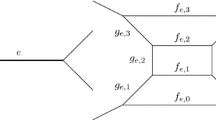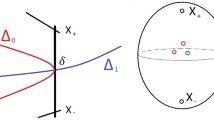Abstract
We show that all toric noncommutative crepant resolutions (NCCRs) of affine GIT quotients of “weakly symmetric” unimodular torus representations are derived equivalent. This yields evidence for a non-commutative extension of a well known conjecture by Bondal and Orlov stating that all crepant resolutions of a Gorenstein singularity are derived equivalent. We prove our result by showing that all toric NCCRs of the affine GIT quotient are derived equivalent to a fixed Deligne–Mumford GIT quotient stack associated to a generic character of the torus. This extends a result by Halpern–Leistner and Sam which showed that such GIT quotient stacks are a geometric incarnation of a family of specific toric NCCRs constructed earlier by the authors.
Similar content being viewed by others
Notes
Hesselink–Kempf–Kirwan–Ness.
\(\tilde{H}\) denotes the reduced singular cohomology.
References
Ballard, M., Favero, D., Katzarkov, L.: Variation of geometric invariant theory quotients and derived categories. J. Reine Angew. Math. arXiv:1203.6643 [math.AG]
Bondal, A., Orlov, D.: Derived categories of coherent sheaves. In: Proceedings of the International Congress of Mathematicians, vol. II (Beijing, 2002), pp. 47–56. Higher Ed. Press, Beijing (2002)
Bocklandt, R.: Generating toric noncommutative crepant resolutions. J. Algebra 364, 119–147 (2012)
Happel, D.: Triangulated Categories in the Representation Theory of Finite-dimensional Algebras, London Mathematical Society Lecture Note Series, vol. 119. Cambridge University Press, Cambridge (1988)
Hara, W.: Non-commutative crepant resolution of minimal nilpotent orbit closures of type a and mukai flops. Adv. Math. 318, 355–410 (2017)
Halpern-Leistner, D., Sam, S.: Combinatorial constructions of derived equivalences (2016). arXiv:1601.02030 [math.AG]
Higashitani, A., Nakajima, Y.: Conic divisorial ideals of Hibi rings and their applications to non-commutative crepant resolutions (2017). arXiv:1702.07058 [math.RT]
Iyama, O., Wemyss, M.: On the noncommutative Bondal–Orlov conjecture. J. Reine Angew. Math. 683, 119–128 (2013)
Iyama, O., Wemyss, M.: Maximal modifications and Auslander–Reiten duality for non-isolated singularities. Invent. Math. 197(3), 521–586 (2014)
Iyama, O., Wemyss, M.: Singular derived categories of \(\mathbb{Q}\)-factorial terminalizations and maximal modification algebras. Adv. Math. 261, 85–121 (2014)
King, A.D.: Moduli of representations of finite-dimensional algebras. Q. J. Math. Oxford Ser. (2) 45(180), 515–530 (1994)
Kirwan, F.C.: Cohomology of Quotients in Symplectic and Algebraic Geometry, Mathematical Notes, vol. 31. Princeton University Press, Princeton (1984)
Kite, A.: Discriminants and quasi-symmetry (2017). arXiv:1711.08940 [math.AG]
Knop, F.: Über die Glattheit von Quotientenabbildungen. Manuscr. Math. 56(4), 419–427 (1986)
Mumford, D., Fogarty, J., Kirwan, F.: Geometric Invariant Theory, Ergebnisse der Mathematik und ihrer Grenzgebiete (2) [Results in Mathematics and Related Areas (2)], vol. 34, 3rd ed. Springer, Berlin (1994)
Špenko, Š, Van den Bergh, M.: Non-commutative resolutions of quotient singularities. Invent. Math. 210(1), 3–67 (2017)
Špenko, Š., Van den Bergh, M.: Noncommutative crepant resolutions for some toric singularities I (2017). arXiv:1701.0525 [math.AG]
Špenko, Š, Van den Bergh, M.: Noncommutative crepant resolutions for some toric singularities II (2017). arXiv:1707.08245 [math.AG]
Van den Bergh, M.: Cohen–Macaulayness of semi-invariants for tori. Trans. Am. Math. Soc. 336(2), 557–580 (1993)
Van den Bergh, M.: Non-commutative Crepant Resolutions, The Legacy of Niels Henrik Abel, pp. 749–770. Springer, Berlin (2004)
Van den Bergh, M.: Three-dimensional flops and noncommutative rings. Duke Math. J. 122(3), 423–455 (2004)
Weyman, J.: Cohomology of Vector Bundles and Syzygies, vol. 149. Cambridge University Press, Cambridge (2003)
Acknowledgements
We thank Jørgen Vold Rennemo for interesting and useful discussions. We also thank the referee for insightful comments.
Author information
Authors and Affiliations
Corresponding author
Additional information
Publisher's Note
Springer Nature remains neutral with regard to jurisdictional claims in published maps and institutional affiliations.
Š. Špenko is a FWO [PEGASUS\(]^2\) Marie Skłodowska-Curie fellow at the Free University of Brussels (funded by the European Union Horizon 2020 research and innovation programme under the Marie Skłodowska-Curie grant agreement No 665501 with the Research Foundation Flanders (FWO)). During part of this work she was also a postdoc with Sue Sierra at the University of Edinburgh. M. Van den Bergh is a senior researcher at the Research Foundation Flanders (FWO). While working on this project he was supported by the FWO grant G0D8616N: “Hochschild cohomology and deformation theory of triangulated categories”.
Appendix A: Appendix by Jason P. Bell
Appendix A: Appendix by Jason P. Bell
By Sect. 3.1, understanding the maximal Cohen–Macaulay cliques reduces to a purely combinatorial problem which is a subject of this section. Let \(a_1,\ldots ,a_d\in {\mathbb N}_{>0}\). In addition, we assume that \(\mathrm{gcd}(a_i)=1\). As a consequence every sufficiently large natural number can be expressed as a linear combination of the \(a_i\) with nonnegative integer coefficients. Let \(N\in {\mathbb N}\). We define
Then \(\mathcal {S}\) contains all but finitely many integers.
Let
Given \(i\in \{0,\ldots ,N-1\}\), we define p(i) to be the smallest positive integer p such that \(i+pN\) is in \(\mathcal {S}_+\). Similarly, q(i) is the largest negative integer q such that \(i+qN\) is in \(\mathcal {S}_{-}\). Let \({\mathcal M}\in \mathfrak {M}\) and let \(j\in \mathbb {Z}{\setminus }{\mathcal M}\). We say that \(m\in {\mathcal M}\) blocks j if \(j-m\in \mathcal {S}\). Notice that if \({\mathcal M}\) is a maximal element of \(\mathfrak {M}\) then for each element in the complement of \({\mathcal M}\) there is necessarily some element of \({\mathcal M}\) that blocks it.
Lemma A.1
Let \({\mathcal M}\in \mathfrak {M}\) be a maximal element of \(\mathfrak {M}\) containing 0 and let \(i\in \{0,\ldots ,N-1\}\). Then \({\mathcal M}\) contains an element that is congruent to i modulo N.
Proof
Suppose not. Then for each \(j\in \{q(i),\ldots ,p(i)\}\) we can choose some integer \(m_j\in {\mathcal M}\) such that \(m_j\) blocks \(i+jN\). Since both \(i+p(i)N\) and \(i+q(i)N\) are in \(\mathcal {S}\), we can take \(m_{p(i)}=m_{q(i)}=0\). Now let
Then \(X_{+}\) and \(X_{-}\) are disjoint and their union is all of \(\{q(i),\ldots ,p(i)\}\). Moreover, since \(m_{p(i)}=m_{q(i)}=0\) and \(q(i)<0<p(i)\), we have \(q(i)\in X_{+}\) and \(p(i)\in X_{-}\). In particular, there must exist some \(j\in \{q(i),\ldots ,p(i)-1\}\) such that \(j\in X_{+}\) and \(j+1\in X_{-}\). Given such a j, we then have
So we may write \(m_j - (i+jN) = N + k_1\) and \(m_{j+1}-(i+(j+1)N) = -N-k_2\), where \(k_1\) and \(k_2\) are \({\mathbb N}\)-linear combinations of the \(a_i\). Subtracting these two equalities, we see
In particular, \(m_j-m_{j+1}= N+k_1+k_2\in \mathcal {S}_+\). But this contradicts the fact that \(m_j,m_{j+1}\in {\mathcal M}\in \mathfrak {M}\). The result follows. \(\square \)
Corollary A.2
Let N be a \({\mathbb N}\)-linear combination of \(a_i\). Let \({\mathcal M}\) be a maximal element in \(\mathfrak {M}\). For every \(0\le i<N\) there exists exactly one element \(m\in {\mathcal M}\) such that \(m\equiv i \,(N)\). In particular, all maximal elements of \(\mathfrak {M}\) have size N.
Proof
Let \({\mathcal M}\) be a maximal element of \(\mathfrak {M}\). By translation we can assume that \(0\in {\mathcal M}\). By Lemma A.1 we have that for each \(i\in \{0,\ldots ,N-1\}\) there is some element of \({\mathcal M}\) that is congruent to i mod N. Thus \(|{\mathcal M}|\ge N\). On the other hand, by definition of \(\mathcal {S}_{+}\) and the assumption on N we have \(\{N,2N,3N,\ldots \}\subseteq \mathcal {S}\). If \({\mathcal M}\) had size strictly larger than N then there would exist \(m,m'\in {\mathcal M}\) with \(m> m'\) and m and \(m'\) congruent to 0 mod N. But then \(m-m'\) is a positive multiple of N and hence in \(\mathcal {S}\). \(\square \)
Rights and permissions
About this article
Cite this article
Špenko, Š., Van den Bergh, M. & Bell, J.P. On the noncommutative Bondal–Orlov conjecture for some toric varieties. Math. Z. 300, 1055–1068 (2022). https://doi.org/10.1007/s00209-021-02910-8
Received:
Accepted:
Published:
Issue Date:
DOI: https://doi.org/10.1007/s00209-021-02910-8




